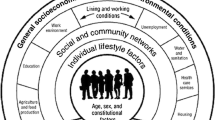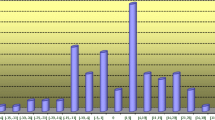Abstract
In this article we present a new composite index of child health, applied to the Least Developed Countries (LDCs) of Africa, one of the areas of the planet most castigated by poverty. Our index has been constructed attending to the variables defined in the Goals of the Millennium Declaration. For this purpose we will use the P2 distance method for the year 2008, the last year for which data are available. This index integrates variables of child health that permit a territorial ordering of the LDCs of Africa, in terms of those partial indicators.

Similar content being viewed by others
Notes
The criteria on which the Development Policy Committee (DPC) based its revision in 2006 of the list of the Less Developed Countries were as follows: (a) A “ low income”, measured by the gross national income (GNI) per capita (average of three years, 2002–2004), with thresholds of 750 dollars for the inclusion of countries in the list and of 900 dollars for their exclusion; (b) The “stocks of human assets”, measured by a composite index (the human assets index) based on indicators of: (i) nutrition (percentage of the population under-nourished); (ii) health (infant mortality rate); (iii) schooling (gross rate of secondary schooling); and (iv) literacy (adult literacy rate); and (c) “Economic vulnerability”, measured by a composite index (index of economic vulnerability) based on indicators of: (i) natural shocks (index of instability of agricultural production; percentage of the population displaced by natural disasters); (ii) commercial shocks (index of instability of exports of goods and services); (iii) vulnerability to shocks (part of GDP corresponding to agriculture, forestry and fishing; index of concentration of exports of goods); (iv) small size of the economy (population expressed in logarithms); and (v) remoteness.
This has occurred in the variables: Average life expectancy at birth; Proportion of births attended by skilled health personnel and the Percentage of children under 5 fever being treated with anti-malarial drug, whose available information is from 2007, while for the Percentage of children under 5 severely underweight we use that existing in 2006.
References
Aghoghovwia, W., & Obiora, C. (2010). Scaling up of intermittent preventive treatment of malaria in pregnancy using sulphadoxine–pyrimethamine: Prospects and challenges. Maternal and Child Health Journal. online first, doi:10.1007/s10995-010-0608-5.
Bethlehem, T., Christine, G., & Camfield, L. (2009). Using qualitative methods with poor children in urban Ethiopia: Opportunities & challenges humanities, social sciences and law. Social Indicators Research, 90, 73–87.
Blau, D. M. (1999). The effects of income on child health development. The Review of Economics and Statistics, 812, 261–276.
Chaaban, J. (2009). Measuring youth development: A nonparametric cross-country youth welfare index. Social Indicators Research, 93(2), 351–358.
Cuenca, E., & Rodríguez, J. A. (2010). Medición de las disparidades entre indicadores asociados al bienestar social en los Países Menos Adelantados (PMA) de Asia. Revista de Economía Mundial, 25, 83–108.
Cuenca, E., Rodríguez, J. A., & Navarro, M. (2010). the features of development in the Pacific Countries of the African, Caribbean and Pacific group. Social Indicators Research. Online first, doi: 10.1007/s11205-010-9594-7.
Escobar, L. (2006). Indicadores sintéticos de calidad ambiental: Un modelo general para grandes zonas urbanas. EURE (Santiago), 32(96), 73–98.
Gordon, D., Nandy, S., Pantazis, C., Pemberton, S., & Townsend, P. (2003). The distribution of child poverty in the developing world. Bristol University: Policy Press.
Hashimoto, A., & Kodama, M. (1997). Has livalidity of Japan gotten better for 1956 1990? A DEA approach. Social Indicators Research, 40, 359–373.
Ivanovic, B. (1974). Comment établir une liste des indicateurs de dévelopement. Revue de Statistique Apliquée, 22(2), 37–50.
López, M. (2003). Bienestar socioeconómico de los municipios gallegos: Una aproximación a su medida. Revista Galega de Economía, 12(2), 1–24.
Mayer, S. (1997). What money can’t buy: Family income and children’s life chances. Cambridge: Harvard University Press.
Mishra, S. K. (2007). Construction of maximin and non-elitist composite indices—alternatives to elitist indices obtained by the principal components analysis. MPRA Paper, 3338. Munich: University Library.
Murias, P., Martínez, F., & Miguel, C. (2006). An economic well-being index for the Spanish Provinces. A data envelopment analysis approach. Social Indicators Research, 77(3), 395–417.
OECD (2002). Society at a glance: OECD social indicator. Paris: OECD.
Pena, J. B. (1977). Problemas de la medición del Bienestar y conceptos afines (Una aplicación del caso español). Madrid: I.N.E.
Pena, J. B. (2009). La medición del Bienestar social: Una revisión crítica. Estudios de Economía Aplicada, 27(2), 299–324.
Phipps, S. (2007). Health outcomes for children in Canada, England, Norway and the United States. Social Indicators Research, 80, 179–291.
Ram, R. (1982). Composite indices de physical quality of life, basic needs fulfilment as income. Journal of Development Economics, 11, 227–247.
Sánchez, M. A., & Rodríguez, N. (2003). El bienestar social en los municipios andaluces en 1999. Revista Asturiana de Economía, 27, 99–119.
Shehzad, S. (2006). The determinants of child health in Pakistan: An economic analysis. Social Indicators Research, 78, 531–556.
Slottje, D., Scully, G., Hirschberg, J. G., & Hayes, K. J. (1991). Measuring the quality of life across countries. Colorado: Westview Press.
Somarriba, N., & Pena, B. (2008). Aproximación a un indicador regional y nacional de los Objetivos de Lisboa a partir de la medida de distancia P2. Estudios Económicos de Desarrollo Internacional, 2, 83–94.
Somarriba, N., & Pena, B. (2009). Synthetic indicators of quality of life in Europe. Social Indicators Research, 96, 115–133.
United Nation (2001). Programme of action for the least developed countries. New York: Oxford University Press.
United Nation (2008). The millennium development goals report. New York: Oxford University Press.
United Nation (2009). The millennium development goals report. New York: Oxford University Press.
United Nation Development Programme (2005). Human development report. United Nations Development Program (UNDP). New York: Oxford University Press.
Van der Hoek, T. (2005). Through children’s eyes: An initial study of children’s personal experiences and coping strategies growing up poor in an affluent Netherlands. Innocenti Working Paper No. 2005–2006, UNICEF Innocenti Research Centre, Florence.
Vicéns, J., & Chasco, C. (2001). Estimación de un indicador de bienestar social de las provincias españolas. Barcelona: Documentos Sociales.
World Health Organization (2004). A strategic framework for malaria prevention and control during pregnancy in the African region. WHO Regional Office for Africa, Brazzaville, Republic of Congo. AFR/MAL/04/01.
Zarzosa, P. (1994). El criterio de discriminación en la selección de indicadores de bienestar. Análisis del Coeficiente de Discriminación de Ivanovic. Estudios de Economía Aplicada, 2, 169–185.
Zarzosa, P. (1996). Aproximación a la medición del Bienestar Social. Valladolid: Secretariado de Publicaciones.
Author information
Authors and Affiliations
Corresponding author
Rights and permissions
About this article
Cite this article
Rodríguez Martín, J.A. An Index of Child Health in the Least Developed Countries (LDCs) of Africa. Soc Indic Res 105, 309–322 (2012). https://doi.org/10.1007/s11205-010-9778-1
Accepted:
Published:
Issue Date:
DOI: https://doi.org/10.1007/s11205-010-9778-1




